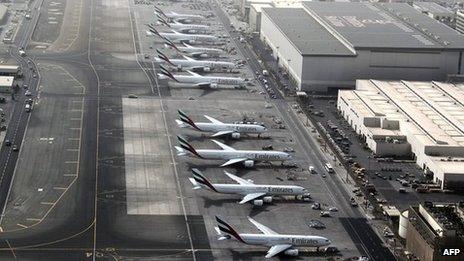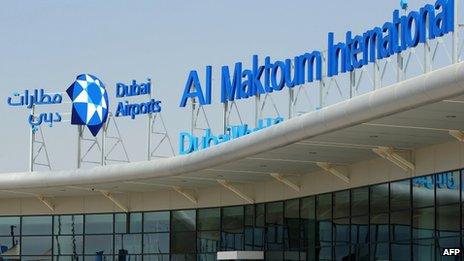Dubai Air Show: Plenty of planes, but is there enough airspace?
- Published

No fly zones have made the airspace even more crowded in the Middle East
New airports, hundreds of billions of dollars worth of new aircraft: some of the big-spending Gulf states and their airlines seem to have limitless resources and ambition.
But the countries have so far been unable to resolve a problem that now threatens their aviation growth.
All those new aircraft ordered at the Dubai Air Show will need space to fly. Trouble is, the airspace above the Gulf is already worryingly congested.
The authorities and the airlines know there is a problem. It's just not clear if anything can be done about it.
"Delays are becoming common place. And delays will only grow as operations grow," warns Hussein Dabbas, regional director of the International Air Transport Association.
"If we don't stop the proliferation of delays, the system will slowly disintegrate - bringing down the efficiency of airlines with it."
The number of aircraft movements through United Arab Emirates' airspace last year was more than 741,000, according to official figures. It is forecast to reach about 895,500 by 2015, and 1.13 million by 2020.
Air travel to and from Qatar, Bahrain, Oman, and elsewhere, is also forecast to rise rapidly.
The problem is that air traffic management in these countries was planned in isolation. The fragmented airspace and lack of co-ordination has historical and geopolitical roots.
The result is a patchwork of boundaries and airspace corridors, and limited co-operation.
"There's no natural single regional body that can grab the issue and deal with it," says John Swift, a former manager of air traffic control at Dubai International Airport.
No-fly zones
Several commissions and working groups have looked into the traffic management problems. "Lots of organisations and airlines want to do something, but progress is slow," he says.
"There's no doubt that congestion is the biggest challenge facing the aviation industry in the Middle East," says Mr Swift, now the Middle East director at NATS, which runs the UK's air traffic services.
Part of the problem is that civil aircraft are off limits to large swathes of airspace used by the military.
In the strategically important UAE, for example, 50% of the airspace is controlled by the defence department, leaving civil aircraft a narrow corridor through which to fly.

The success and rapid expansion of Gulf-based airlines has resulted in new infrastructure being built in the region
In Europe, countries have a flexible approach to airspace. Civil and military aircraft use airspace according to need, Mr Swift says. "Both sides are able to carry out their business and national defence operations without problem.
"Aviation officials from the Middle East who visit NATS in the UK are often surprised to see civil and military controllers sitting side by side," he says. "But it is an approach that the region could certainly benefit from."
Mr Swift, who advised UAE authorities on airspace issues for the construction of Dubai's new airport, says technology is not an issue. Many Gulf countries have state-of-the-art air traffic management systems.
The UAE's Sheikh Zayed Air Navigation Centre was opened in 2009, and is one of the most sophisticated in the world.
So, unlocking more military airspace for civil use is not a technical problem, Mr Swift says. It is more a question of will and determination.
Losing faith
All the parties seem to agree that co-operation and co-ordination is key. But that has so far proved easier said than done.
The UAE has a general civil aviation regulator, but the Emirates also have individual authorities. They meet regularly, including with the military. Scale up this bureaucracy to a regional level, and you have a maze of competing interests.
The frustration among those who run airports and airlines is evident.
Needless concerns over sovereignty, nationalism and politics "are getting in the way of logic", said Dubai Airports' chief executive Paul Griffiths in a recent widely reported speech. Huge investment on the ground was now threatened by a failure to address airspace issues, he warned.
It is particularly important for the UAE, where aviation forms such a substantial part of the economy. In Dubai, aviation is almost 25% of GDP and a huge employer.
Dubai Airport is next year expected to overtake Heathrow as the biggest in the world. The new $32bn (£19.8bn) Al Maktoum International will be even bigger.

Dubai's Al Maktoum International Airport lies half an hour's drive outside the city
The UAE is not just a tourist destination. Abu Dhabi, Dubai, along with near-neighbour Qatar, are vital connection hubs for people criss-crossing the globe.
Reports of missed flights caused by delays on the ground and circling overhead are growing.
Transit-travellers have plenty of alternatives, such as Singapore. Turkey is investing heavily to ensure Istanbul exploits its geographical position.
"If people start losing faith in the business model, that will be a serious problem," Mr Swift says. "Eventually, people will have to start thinking about about protecting their investment. An aircraft on the ground does not make money."
'Difficult choices'
Mr Swift describes airspace as an "invisible infrastructure" that should be treated and managed like an economic asset. "If any asset is underperforming, it undermines the business model. Present the problem in financial terms, and it might spur action."
Last month, Airbus ProSky, the air traffic management division of planemaker Airbus, completed an official report on how better to manage UAE airspace.
It made 53 recommendations.
Ahmed Al Jallaf, chairman of the UAE National Airspace Advisory Committee, says the recommendations meant that the authorities had some "difficult choices" to make.
"Times will become more challenging as we start working on the implementation of the [Airbus ProSky] study," he says.
However, none of the recommendations have been made public. Many people can only guess at the future strategy.
Yet, even if the UAE gets its airspace in order, other states for whom aviation is not a core economic interest may not follow suit.
In Europe, so-called Functional Airspace Blocks are organised along the most appropriate operational needs, regardless of country boundaries. Europe is moving towards an eventual Single European Sky.
For many people, a similar model is the only answer for the Gulf. But it is years away at best, and few people would disagree that the region needs this now.